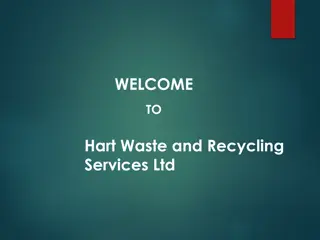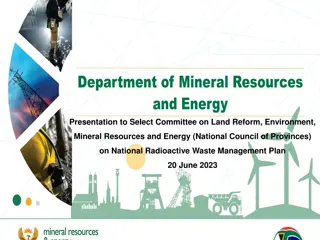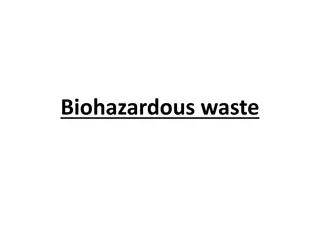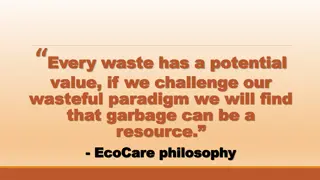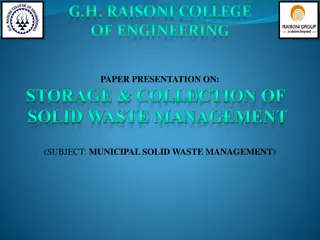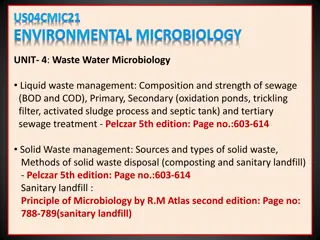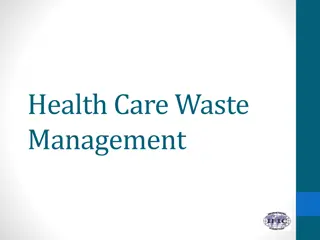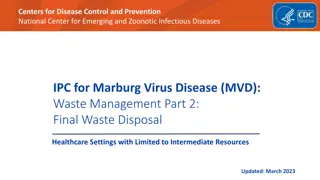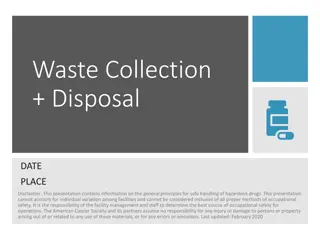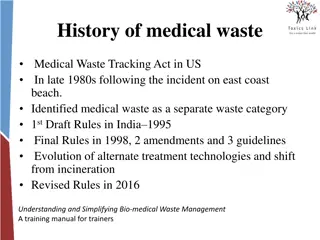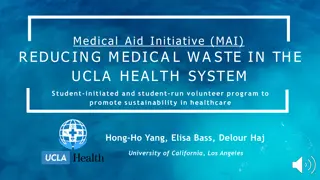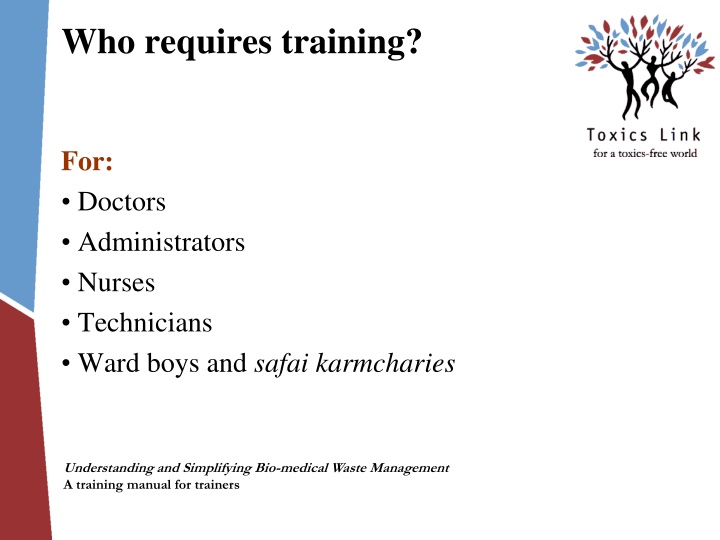
Bio-medical Waste Management Training for Healthcare Personnel
This manual provides comprehensive guidance on bio-medical waste management training for doctors, administrators, nurses, technicians, ward boys, and safai karmcharies. It covers the need for waste management, dangers to patients and healthcare workers, sharps identification, and more. The training sessions involve teaching, discussions, feedback, and ongoing education led by hospital personnel and external agencies.
Download Presentation

Please find below an Image/Link to download the presentation.
The content on the website is provided AS IS for your information and personal use only. It may not be sold, licensed, or shared on other websites without obtaining consent from the author. If you encounter any issues during the download, it is possible that the publisher has removed the file from their server.
You are allowed to download the files provided on this website for personal or commercial use, subject to the condition that they are used lawfully. All files are the property of their respective owners.
The content on the website is provided AS IS for your information and personal use only. It may not be sold, licensed, or shared on other websites without obtaining consent from the author.
E N D
Presentation Transcript
Who requires training? For: Doctors Administrators Nurses Technicians Ward boys and safai karmcharies Understanding and Simplifying Bio-medical Waste Management A training manual for trainers
Trainers Initially Hospital personnel Outside agency Ongoing training Hospital Infection Control Committee Medical Superintendent Nursing Supervisor Sanitary Supervisor Understanding and Simplifying Bio-medical Waste Management A training manual for trainers
Training sessions Teaching Discussion Feedback Ongoing training (once at the time of induction and thereafter once a year) Training module: Vernacular medium Easy to understand Include equipments and slides Demonstration Understanding and Simplifying Bio-medical Waste Management A training manual for trainers
Training session one Inputs from trainees: About the present system The need of managing waste Their role and intervention Introducing concepts of waste management Understanding and Simplifying Bio-medical Waste Management A training manual for trainers
Sensitisation the need for managing waste Dangers to the patients Many patients immuno-compromised Dangers to the community Spread of infection through waste Access of waste to the animals Problems due to incinerators Spread of infection through recycling trade Understanding and Simplifying Bio-medical Waste Management A training manual for trainers
Dangers to healthcare workers Hours spent at the workplace High rate of needle-stick injuries Exposure to mercury/chemicals Dangers due to improper spill handling Dangers due to on-site incinerators. Understanding and Simplifying Bio-medical Waste Management A training manual for trainers
What are sharps? Anything capable of causing cuts and punctures: Needles Blades Scalpels Lancets Sutures I.V. catheters Glass Understanding and Simplifying Bio-medical Waste Management A training manual for trainers
Categories of staff exposed to needle-stick Staff prone to needle stick injuries Staff nurses Interns Residents Practical nurses Technical staff Environmental workers Others Relative % of injury 34.6% 15.7% 11.7% 8.5% 6% 19% 4.5% Understanding and Simplifying Bio-medical Waste Management A training manual for trainers
Incidents leading to pricks Type of incident % Blood drawing 22.6 Garbage collection 12.5 Placing intravenous lines 11.3 Recapping 11 Needle disposal box 10.5 Administering medication 8.5 Neglected needle 4.8 Cleaning surgical equipment 2.8 Others 16 Understanding and Simplifying Bio-medical Waste Management A training manual for trainers
Sero-conversion following exposure Pathogen HIV 0.3% HBV HCV 10% Sero-conversion rate Time of conversion 6 months 2-6 months 7 weeks 30% Understanding and Simplifying Bio-medical Waste Management A training manual for trainers
Mercury products in hospitals Product Thermometers Sphygmomanometers Esophageal Abbott & Cantor tubes Tungsten Dental amalgams Alternative Digital, expansion or aneroid Electronic vacuum gauge, expansion /aneroid Dilators, Products w/Miller tubing Gold, ceramic, porcelain Understanding and Simplifying Bio-medical Waste Management A training manual for trainers
Symptoms of mercury poisoning Impairment of peripheral vision Disturbance in sensations Lack of coordination of movements Impairment of speech or hearing Muscle weakness Skin rashes Mood swings, mental disturbance Abnormal brain development; impaired memory, attention and learning Understanding and Simplifying Bio-medical Waste Management A training manual for trainers
Mercury effects Damage to the brain, the kidneys and developing foetus. Effects on brain functioning may result in irritability, shyness, tremors, changes in vision or hearing, and memory problems. In addition, short-term exposure to high levels of metallic mercury vapours may cause effects including lung damage, nausea, vomiting, diarrhea, increases in blood pressure or heart rate, skin rashes, and eye irritation. Understanding and Simplifying Bio-medical Waste Management A training manual for trainers
Where is glutaraldehyde used? Endoscopy units Theatres ICU Labour wards Infection control Dental units Understanding and Simplifying Bio-medical Waste Management A training manual for trainers
Glutaraldehyde and you! Irritates skin, eyes, throat and lungs, causes sensitisation of skin and respiratory tract Can cause allergic reaction, like asthma Skin sensitisation and contact dermatitis Headache, shortness of breath, chest pain, discomfort, cough and fatigue Understanding and Simplifying Bio-medical Waste Management A training manual for trainers
Cytotoxic drugs Ability to kill or arrest the growth of living cells Used for treatment of cancerous cells Harmful to normal cells specially the actively dividing cells Exposure happens mainly through inhalation of droplets or dusts. Can be absorbed through the skin, or by swallowing food/beverages contaminated with CDs. Risks for exposure are during the preparation and administration of the drugs, handling of body fluids from patients being treated with cytotoxic drugs Understanding and Simplifying Bio-medical Waste Management A training manual for trainers
Cytotoxic drugs-health effects Short term effects:skin injury, lightheadedness, dizziness, nausea, headache, and allergic reactions Long term effects:Some anti-neoplastics can cause cancer, they may also cause birth defect (teratogens) and miscarriages, as well as chromosomal damage (mutagens) Understanding and Simplifying Bio-medical Waste Management A training manual for trainers
Other aspects Dangers to ragpickers Sorting of mixed hospital waste Needle-stick injuries Bio-Medical waste Management Rules 2016: Fines and legal implications on non-compliance Implementation is a shared responsibility of the entire staff Understanding and Simplifying Bio-medical Waste Management A training manual for trainers

